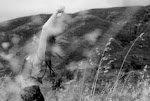
Ricardo Garabito "El Banquete" pencil, tempera and watercolor.
Courtesy Malba, Buenos Aires.
Ricardo Garabito's art is not frequently seen in Buenos Aires. He cannot exhibit his work every year because it takes him more than that to evolve. He is not the type of artist who would hang his work anywhere just to be "in" the artistic scene of Buenos Aires. It is only after working on numerous paintings that he feels he can choose the best ones and show them to the public. Born in 1930, he has exhibited his work only 11 times. That's why Malba's exhibition of his oil paintings, drawings and watercolors until August 29 is special.
Critics say he is a realist. He paints human figures and still life but uses color as the Fauvists did, chooses subject matters as the surrealists did, puts 3-d figures in 2-dimensional backgrounds and has a peculiar way of using light. Fitting him only into the category of realism would simply not be enough.
His topic is ordinary life. He depicts men, women, still life and a lot of plastic: bottles of bleach, bathroom cleaner, buckets, milk bottles and food cans. His most interesting characters fit into the category of "mersas", an Argentinism used in the 60's and 70's referring to people that did not take care of their own manners or personal appearance.
Some of his models have unfashionable hair cuts from neighborhood's beauty salons, men appear wearing white under t-shirts and women wear fashion items in their chubby bodies and in the most unfashionable way possible. Garabito's characters are anti heroes! His painting is ironic, borders on vulgarity and funny. He has seriously managed to laugh at the aesthetics of every day life.
Garabito studied painting for three years until his teacher - Horacio Butler - told him it was time to move on. He realized that if he was going to paint, he could not copy what other colleagues were doing in an attempt to fit in. He decided to be authentic, to be himself, and that, he achieved indeed.
On view at MALBA: Avenida Figueroa Alcorta 3415
Post by: Valeria Mendez Cañas.

































